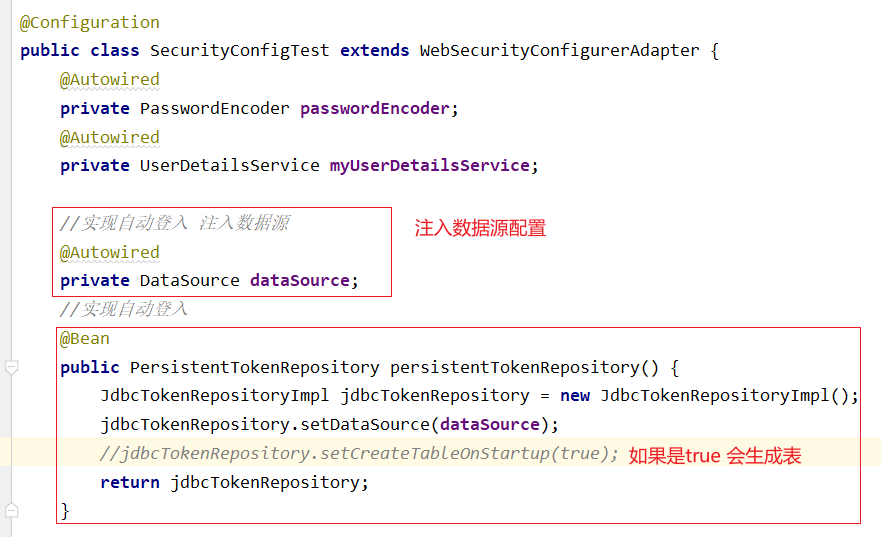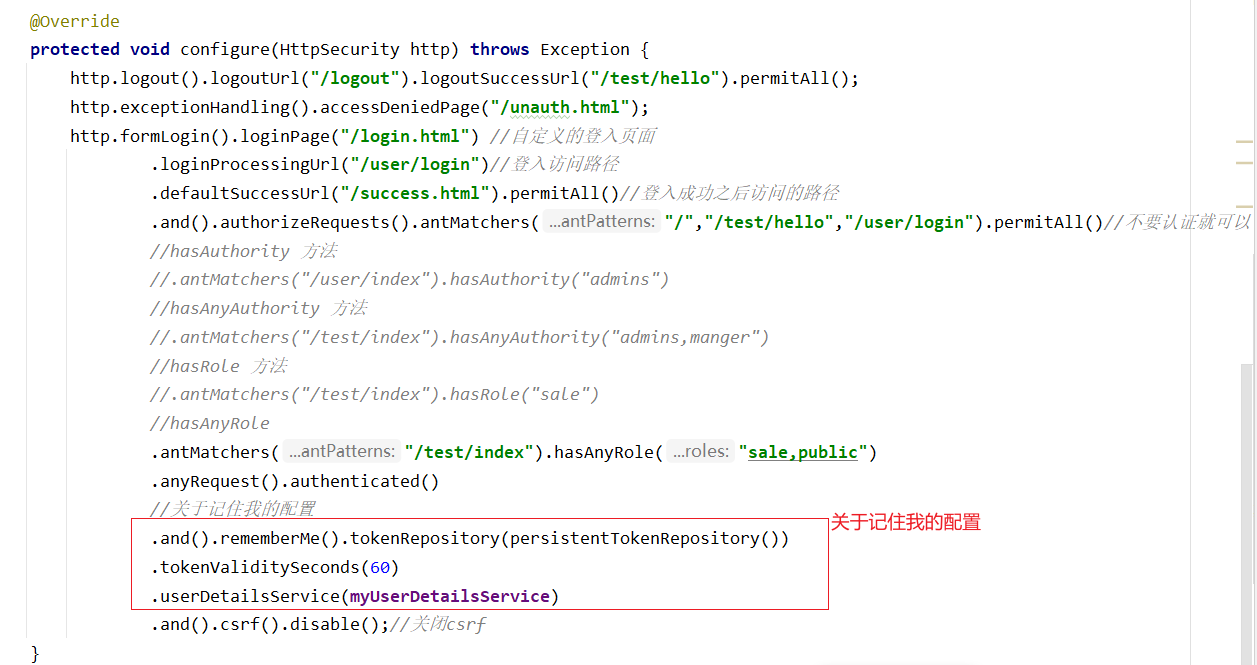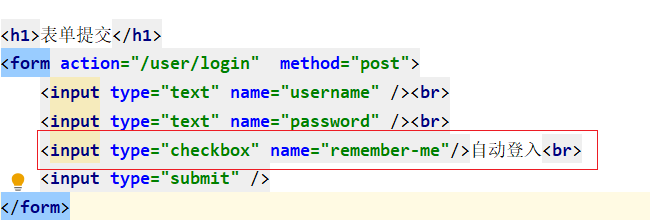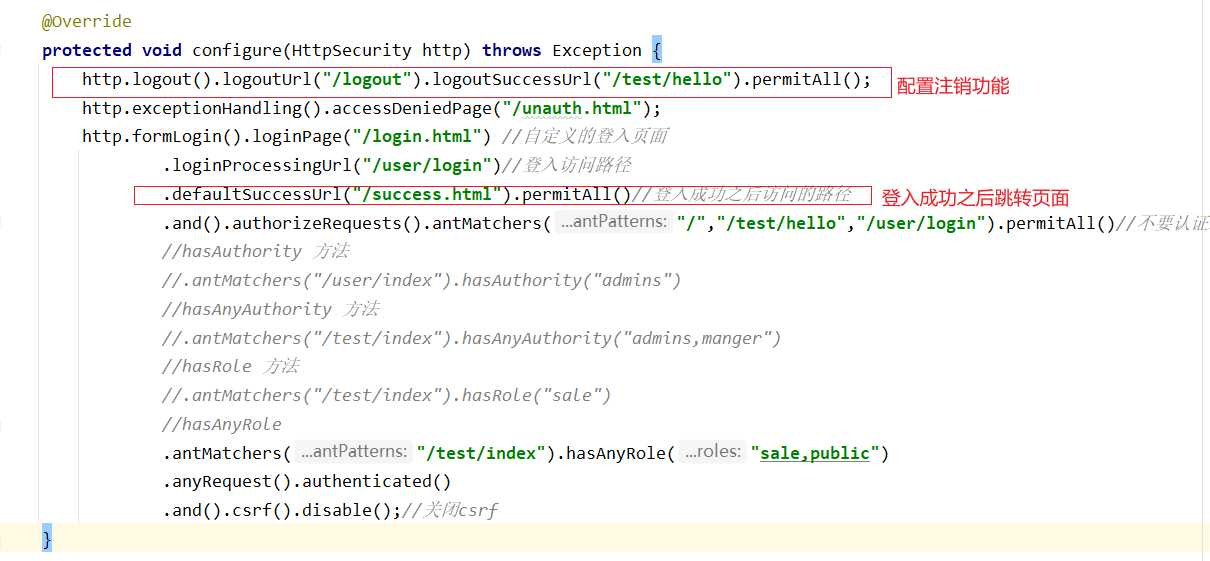65、SpringSecurity基本的使用
1、添加SpringSecuruty的依赖
2、测试SpringSecurity
3、两个很重要的接口:UserDetailsService PasswordEncoder
3.1、如果要自定义登入
第一步创建一个类 继承 UsernamePasswordAuthenticationFilter 重写三个方法:attemptAuthentication successfulAuthentication unsuccessfulAuthentication
第二部创建类 实现 UserDetailsService 实现一个方法 loadUserByUsername
第三步创建类 PasswordEncoder接口的子类
二、用户名和密码配置的三种方式
1、通过配置文件配置
spring.security.user.name=edwin
spring.security.user.password=edwin
2、通过配置类的方式
@Configuration public class SecurityConfig extends WebSecurityConfigurerAdapter { @Autowired private PasswordEncoder passwordEncoder; @Override protected void configure(AuthenticationManagerBuilder auth) throws Exception { auth.inMemoryAuthentication().withUser("admin").password(passwordEncoder.encode("123")).roles("admin"); } @Bean public PasswordEncoder passwordEncoder () { return new BCryptPasswordEncoder(); } }
3、自定义的方式
创建配置类
@Configuration public class SecurityConfigTest extends WebSecurityConfigurerAdapter { @Autowired private PasswordEncoder passwordEncoder; @Autowired private UserDetailsService myUserDetailsService; @Override protected void configure(AuthenticationManagerBuilder auth) throws Exception { auth.userDetailsService(myUserDetailsService).passwordEncoder(passwordEncoder); } @Bean public PasswordEncoder passwordEncoder() { return new BCryptPasswordEncoder(); } }
自定义实现的UserDetailService
@Service(value = "myUserDetailsService") public class MyUserDetailsService implements UserDetailsService { @Override public UserDetails loadUserByUsername(String username) throws UsernameNotFoundException { List<GrantedAuthority> authorities = AuthorityUtils.commaSeparatedStringToAuthorityList("roles"); return new User("joe",new BCryptPasswordEncoder().encode("123"),authorities); } }
三、通过查询数据库的用户完成认证操作
1、添加依赖
<dependency>
<groupId>com.baomidou</groupId>
<artifactId>mybatis-plus-boot-starter</artifactId>
<version>3.4.1</version>
</dependency>
<dependency>
<groupId>mysql</groupId>
<artifactId>mysql-connector-java</artifactId>
</dependency>
<dependency>
<groupId>org.projectlombok</groupId>
<artifactId>lombok</artifactId>
</dependency>
2、创建数据表的结构
CREATE TABLE `users` ( `id` int(11) NOT NULL AUTO_INCREMENT, `username` varchar(255) NOT NULL, `password` varchar(255) NOT NULL, PRIMARY KEY (`id`) ) ENGINE=InnoDB AUTO_INCREMENT=3 DEFAULT CHARSET=utf8;
3、创建实体类
@Data @TableName("users") public class Users { @TableId(type = IdType.AUTO) private Integer id; private String username; private String password; }
4、创建Mapper接口查询数据库
@Mapper public interface UsersMapper extends BaseMapper<Users> { @Select("select *from users where username =#{username}") Users selectUserByUsername(String username); }
5、补充业务代码
@Service(value = "myUserDetailsService") public class MyUserDetailsService implements UserDetailsService { @Autowired private UsersMapper usersMapper; @Override public UserDetails loadUserByUsername(String username) throws UsernameNotFoundException { List<GrantedAuthority> authorities = AuthorityUtils.commaSeparatedStringToAuthorityList("roles"); QueryWrapper<Users> wrapper = new QueryWrapper<>(); wrapper.eq("username",username); Users users = usersMapper.selectOne(wrapper); if(users == null){ throw new UsernameNotFoundException("用户不存在!"); } return new User(users.getUsername(),new BCryptPasswordEncoder().encode(users.getPassword()),authorities); } }
四、权限控制方法 hasAuthority hasAnyAuthority, hasRole hasAnyRole
//.antMatchers("/user/index").hasAuthority("admins") //hasAnyAuthority 方法 //.antMatchers("/test/index").hasAnyAuthority("admins,manger") //hasRole 方法 //.antMatchers("/test/index").hasRole("sale") //hasAnyRole .antMatchers("/test/index").hasAnyRole("sale,public")
五、Security 的注解的使用
1、Secured注解的使用,在启动类或者配置类中开启:@EnableGlobalMethodSecurity(securedEnabled = true)
@GetMapping(value = "/update") @Secured("ROLE_sale,ROLE_sale1") public String update() { return "Hello Update"; }
2、PreAuthorize注解的使用 在启动类或者配置类中开启: @EnableGlobalMethodSecurity(securedEnabled = true,prePostEnabled = true)
@GetMapping(value = "/update") //@Secured("ROLE_sale") @PreAuthorize("hasAnyAuthority('ROLE_sale')") public String update() { return "Hello Update"; }
六、用户注销操作![]()
2、登入成功的页面
<!DOCTYPE html>
<html lang="en">
<head>
<meta charset="UTF-8">
<title>Title</title>
</head>
<body>
<div>
登入成功!
<a href="/logout">退出登入</a>
</div>
</body>
</html>
六、实现记住我,Security 自动登入![]()











 浙公网安备 33010602011771号
浙公网安备 33010602011771号